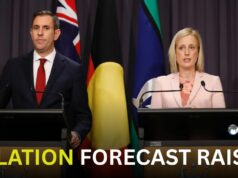Having slapped excruciating tariffs on China, is Donald Trump also trying a ‘Reverse Nixon’ strategy? Tariffs on Chinese exports to the U.S. now stand at over 100%. Trump wants a deal but China hasn’t signalled it is game. That’s the business part. But Trump’s China approach seems to have a bit of geopolitics as well.
Trump is keen on ending the Russia-Ukraine war. U.S.-mediated talks have so far produced a limited yet disputed ceasefire on energy infrastructure. Earlier this week, Trump reiterated his call for a ceasefire and urged Putin to halt violence. “We are talking to Russia. We would like them to stop. I don’t like the bombing. The bombing goes on and on, and every week thousands of young people are being killed,” Trump told reporters. His keenness on easing tensions with Russia seems apparent.
Wider scholarship claims that continued hostility towards Russia would simply push it further into the Chinese camp. So, Trump’s overtures to Putin attempt to drive a wedge between Russia and China’s growing alliance. He aims to reverse Nixon’s rapprochement strategy with China, which he designed to oppose the Soviet Union. It eventually contributed to shifting the Cold War balance of power. Whether Trump can pull off a ‘Reverse Nixon’ strategy remains doubtful.
In 1972, President Nixon paved the way for normalisation of relations with China, with his landmark visit to Beijing. It further deepened the contestation between China and then Soviet Union. Donald Trump’s strategy to bring Russia closer seems to imply two geopolitical realities. First, this time around, China is not a junior partner in the Russia-China partnership. And there is a pressing need to tackle the China threat to the U.S.-led world order. Second, Trump realizes the power dynamics shifting towards the Indo-Pacific region. Europe’s diminished strategic value has become increasingly evident.
The United States seeks to “break Russia’s alliance with those of China, Iran and North Korea”, special envoy for Ukraine and Russia, Keith Kellogg, announced at the Munich Security Conference. Trump’s bold moves have the potential to turn the tables if they could realign Russia and reduce its dependency on China.
Each strategy needs to be viewed in the context of its time. Nixon’s visit set the groundwork for rapprochement with China. By that time, fraternal ties between the Soviet Union and China had taken a dramatic shift. Mao broke off the party-to-party relations by boycotting the 23rd Congress of the Soviet Union’s Communist Party. In 1969, the ideological split escalated to border clashes along the banks of the Ussuri River. Nixon’s trip to Beijing exploited the existing animosity in U.S. favour by isolating the Soviet Union.
Now, times are different. “I think the relationship between the Chinese and the Russians has become so integrated and deep that the idea to separate them is very far-fetched,” David Santoro, President of the Pacific Forum told StratNews Global in a recent interview.
While cheap Russian oil dominates China’s imports, Chinese companies are exporting manufactured goods to Russia. The supply of dual-use civilian-military products along with agricultural products has found a place in the Chinese domestic market. China has been reluctant to condemn Russia’s actions in Ukraine by abstaining rather than voting against the UN resolutions. Furthermore, China continues to struggle to build an indigenous jet engine and relies heavily on Russia for the same. The military cooperation has only intensified, with both countries frequently conducting joint naval and aerial exercises.
Trump’s efforts to pull off a ‘reverse Nixon’ might backfire by risking the transatlantic security alliance. The Trump administration has sidelined Europe in the ceasefire talks and put it on the back foot. It has caused alarm about NATO’s future to a new level since Europe solely depends on the American security umbrella. Many U.S. presidents have expressed frustration with Europe’s reliance on American military protection. Yet the belief in earlier US administrations was that Europe is essential to America’s global leadership.
Can the transatlantic alliance manage to remain integrated under Trump 2.0? “Europe’s going to follow the U.S. lead and build up its defences, so NATO will be strong,” says James Carafano, Senior Fellow at the Heritage Foundation.
The American alliance network has played a crucial role in maintaining U.S. hegemony and superpower status for decades. Trump’s diplomatic manoeuvre to counter China must not forget the leverage alliances hold in the great power game. China certainly has gained great power status but lacks the capability to qualify as a superpower. It is struggling to establish a sphere of influence in the contested neighbourhood.
President Nixon’s visit to China became a defining moment of the Cold War. It sought to counter its archrival, the Soviet Union, and ultimately led to its disintegration. But Trump’s efforts to counter the China threat through the ‘reverse Nixon’ strategy could become a strategic blunder.





